Need to select decorative restaurant lighting for your project? Discover all the elements to consider and the 11 steps to follow.
In the era of food design, where food and everything that surrounds it become the object of careful study and planning, satisfying the view is just as important as satiating the palate.
In this new scenario, the type of decorative lighting chosen, as well as the arrangement of the lighting fixtures, are a more fundamental component than ever in restaurant design.
Making mistakes in the choice of lighting would jeopardize the entire project and affect the guest experience.
According to a recent study, 72% of guests would leave the restaurant even before the start of service due to poor or excessive lighting, while 74%, appreciating the welcoming and relaxing atmosphere created by the lighting, would increase their time at the restaurant.
Therefore, beyond the quality of the culinary proposal, identifying the right solution for restaurant lighting is a key element in determining its success.
In this article, we will delve into all the fundamental aspects to carry out a successful lighting design project for a restaurant and the 11 fundamental steps to follow to make the most of the potential of decorative lighting.
In particular, we will take a look at:
- What are the main lighting levels?
- Decorative lighting for restaurants: the 11 steps to follow
- Make lighting the focus of your project
- Use multiple lighting solutions
- Guide guests with light
- Choose decorative lighting for the restaurant based on the concept
- Create the right atmosphere by playing with different degrees of brightness
- Use colors sparingly
- Highlight the dishes
- Pay attention to customer comfort
- Be aware of trends
- Find the right compromise between functionality and design
- Calculate the lumens needed
- Natural light: how to make the most of it
- Decorative lighting styles based on the type of restaurant
- Decorative lighting for restaurants: combining style and functionality
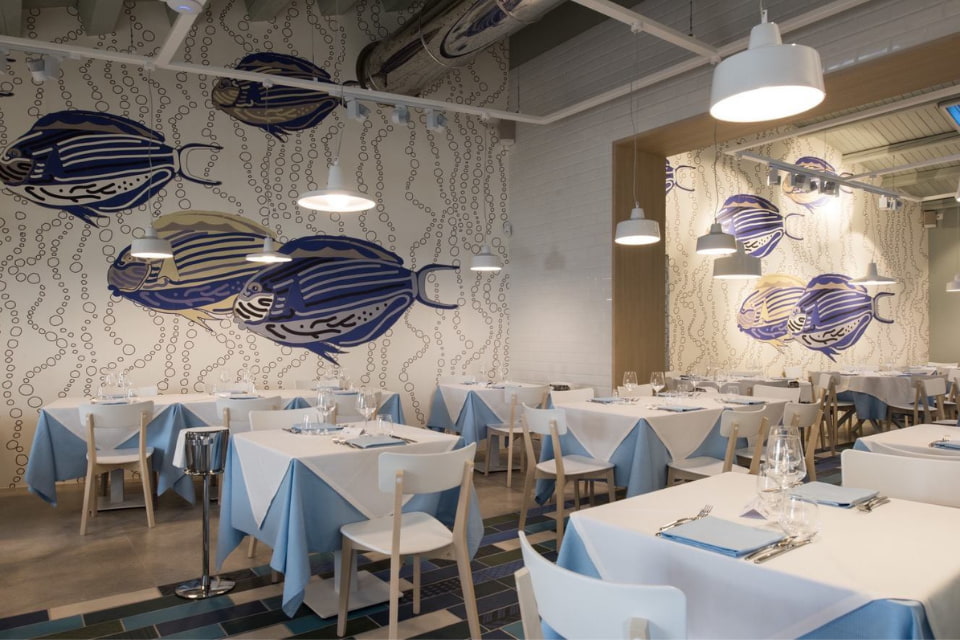
Gangster
What are the main lighting levels?
Before going into the merits of which idea of decorative lighting for restaurants best meets the specific needs of each individual lighting project, it is useful to distinguish the three main levels of illumination and their peculiarities.
In fact, only by skilfully mixing these levels will it be possible to give the right atmosphere to any environment through light.
- Ambient lighting constitutes the main light source in a room and allows those occupying it to move freely while enjoying good visibility.
Inside a restaurant, ambient lighting can be obtained, for example, through the use of ceiling lamps. They will guarantee a good general luminosity and will make the ceiling the primary source of light - Task lighting allows you to easily carry out specific activities at, for example, the restaurant tables, which can be illuminated with suspension lamps or some table lamps
- Accent lighting has the function of giving density to the spaces and drawing attention to specific focal points. Decorative lighting, in this case, is used to illuminate architectural details, works of art, furnishings, or sculptures
Based on this classification, however, the type of lighting chosen can also fall into one or the other category based on the position it occupies in the environment and the time of day.
Decorative lighting for restaurants: the 11 steps to follow
The first impression is what matters most, and the decorative lighting solution you choose for a restaurant says a lot about its atmosphere and the idea of the restaurant you want to express.
What is the best way to configure the image of a business and create an atmosphere in each space by playing with the lighting points?
Here are 11 basic steps to follow to transform a simple lighting solution into a real aesthetic element capable of giving functionality and a personal touch to the room.
1. Make lighting the focus of your project
Having a clear and defined general picture of the lighting project will be essential to achieving the desired end goal in terms of a coherent overall mood and creating the right atmosphere.
For example, if you decide to opt for table lamps to light up the tables, you will need to position the electrical sockets in a strategic and functional way, unless you choose battery-operated table lamps like Bacco, a refined “table light”, whose design proposes the shape of a bottle, in white satin glass.
2. Use multiple lighting solutions
As we have seen, a successful lighting design project requires you to apply multilevel lighting.
The first type of lighting you should think about is ambient lighting, which, in addition to being the main light source, if applied strategically, has the ability to make the ceilings seem higher and the most spacious environments.
Then the task lighting installation comes into play, to be applied in specific locations such as the cash register or counter, etc.
Finally, accent lighting comes in to play to focus attention on design details and furnishings that characterize the restaurant.
By using these three types of lighting in a complementary way, the result will be: a synergy of light and shadows able to outline the profile and personality of the place in a unique and original way.
3. Guide guests with light
For the customers, being able to orient yourself immediately and intuitively in a room is essential to feeling completely at ease. Guests, in a matter of seconds, must be able to find their own table and sit down as well as reach the other areas of the room effortlessly, whether it is the bathroom, cash register, or access to the outdoor areas where present.
Therefore, to guide the customer with lighting, one must play on brightness contrasts, combining the use of accent lighting and ambient lighting. In this way, the eye will focus on the focal areas highlighted.
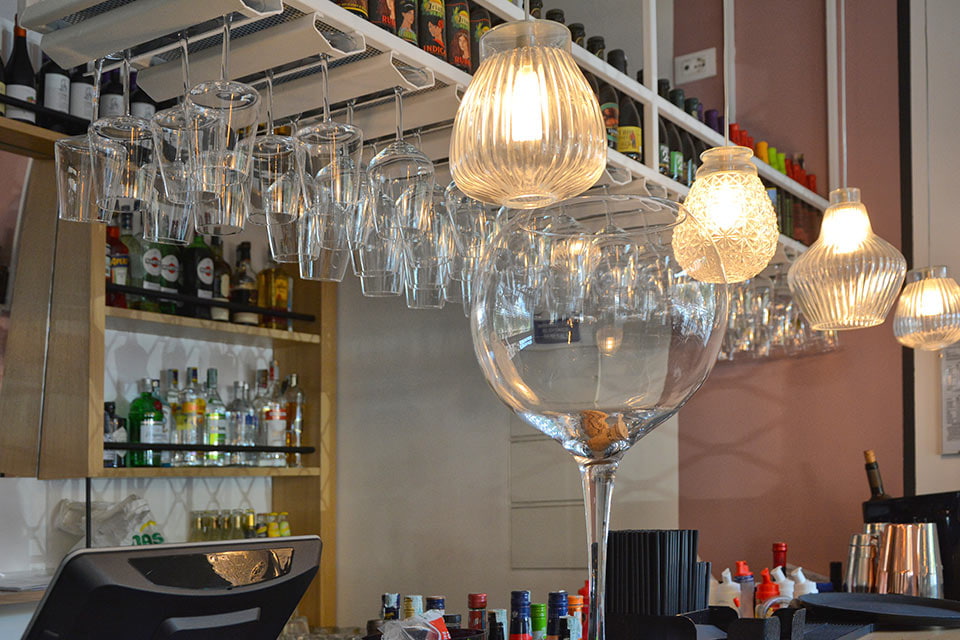
Ceraunavolta
4. Choose decorative lighting for the restaurant based on the concept
The concept, the space available, and the type of clientele you want to attract are the three factors that should most guide the choice of decorative lighting solutions for your lighting design project.
To design the lighting of a restaurant every detail must comply and be in harmony with the spaces of the venue and with what you want to highlight.
5. Create the right atmosphere by playing with different degrees of brightness
Light is the fundamental basis on which to create the atmosphere of a room.
Finding the right color temperature is a fundamental step. You don’t want to make mistakes that would create clashes with the mood you want to set.
According to the most experienced and specialized lighting designers in the food service, warm lighting gives guests a greater sensation of relaxation, especially if installed in environments with a cold and aseptic appearance.
The term "warm lights" refers to lamps that do not exceed 3000 Kelvin.
A clever idea, for example, is to connect a dimmer to the led bar, which allows you to adjust the brightness according to the time of day.
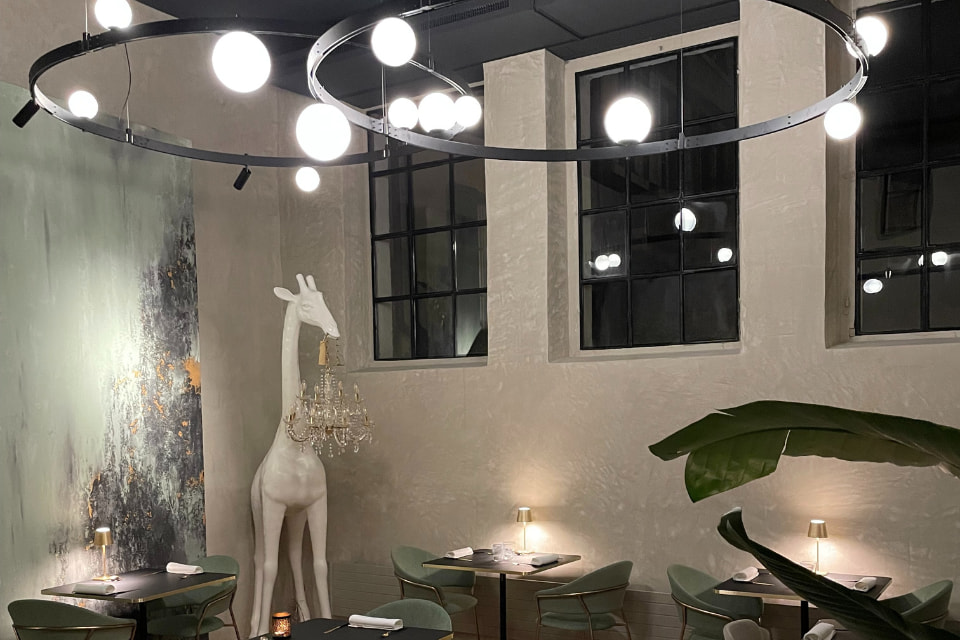
Stant
6. Use colors sparingly
Sometimes the bar corner is lit differently than the restaurant, whose lighting usually tends to create a bubble of relaxation and privacy within the room.
Bright back bars installed on the bar area, besides providing light, often entertain the eye by changing color.
Giving a touch of color to the bar area is obviously not an option common to all designers since it depends on a purely stylistic choice, which must in any case be in line with the location’s mood.
Only caveat: yes to the colors, but without exaggerating.
7. Highlight the dishes
In a restaurant, especially high-level ones where the chefs create real culinary works of art, it is essential that the lights reveal the color of the foods and ingredients on the plate realistically.
The highest color rendering index is 100, and the minimum required for restaurant lighting is 80, but it would be better to opt for lights with an IRC equal to 90.
Choosing the wrong color rendering index means precluding the full achievement of the visual experience, which inevitably affects the customer’s evaluation.
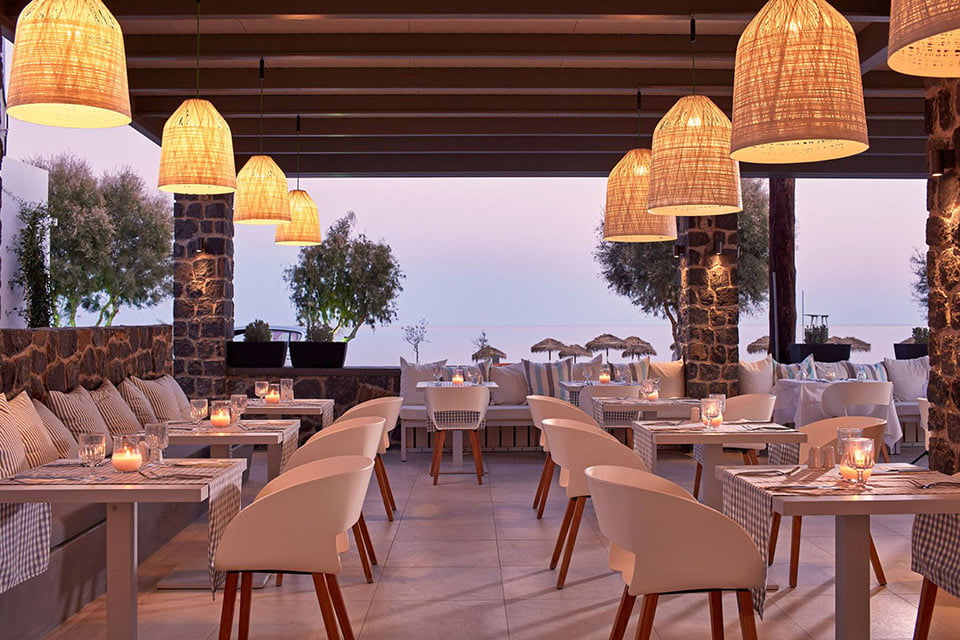
Black Out
8. Pay attention to customer comfort
Comfort and functionality complement each other. The customer must be placed in the best conditions to read the menu and clearly see what they are eating, without an annoying glare.
To avoid these situations, which would jeopardize the customer's comfort, one could opt for lamps with fabric or frosted glass diffusers, or place light sources directly outside of the field of view, away from potential reflective surfaces.
9. Be aware of trends
Trends are born and die continuously but some are destined to remain for a long time if not to never completely disappear.
Today, lighting designers specializing in food service speak of a return to the origins, which must be taken into account.
It is evident, for example, how lamps without lamp shades are back in vogue in clubs, with uncovered suspension cords.
10. Find the right compromise between functionality and design
Identifying decorative lighting for a restaurant that knows how to personalize the environment through an immediate style statement and that it is, at the same time, functional for both the customer and the staff at work, is undoubtedly the biggest challenge for a lighting designer, but also the secret of the project's success.
Basically, what is essential to do is to find the perfect balance between decorative lighting and technical lighting.
11. Calculate the lumens needed
Last but not least, for the lighting of a restaurant, as well as any other private or contract environment, it is essential to calculate how many lumens are needed to illuminate each area.
This value depends both on the surface to be illuminated and on the intensity of the light, called Lux.
So lumen= lux x sqm.
By calculating this value, it will be possible to identify the most suitable bulbs or light installation.
The average illuminance for the kitchen (an area for professionals only), by law, must not be less than 500 lux and for the room a minimum color rendering of 80 units out of 100 must be respected. However, the calculation for the other environments will be carried out having a clear idea of the type of atmosphere that you want to set based on the type of clientele you are targeting.
Just to give an example, a restaurant with very soft and refined lighting will much more likely attract a certain type of adult clientele rather than groups of very young children.
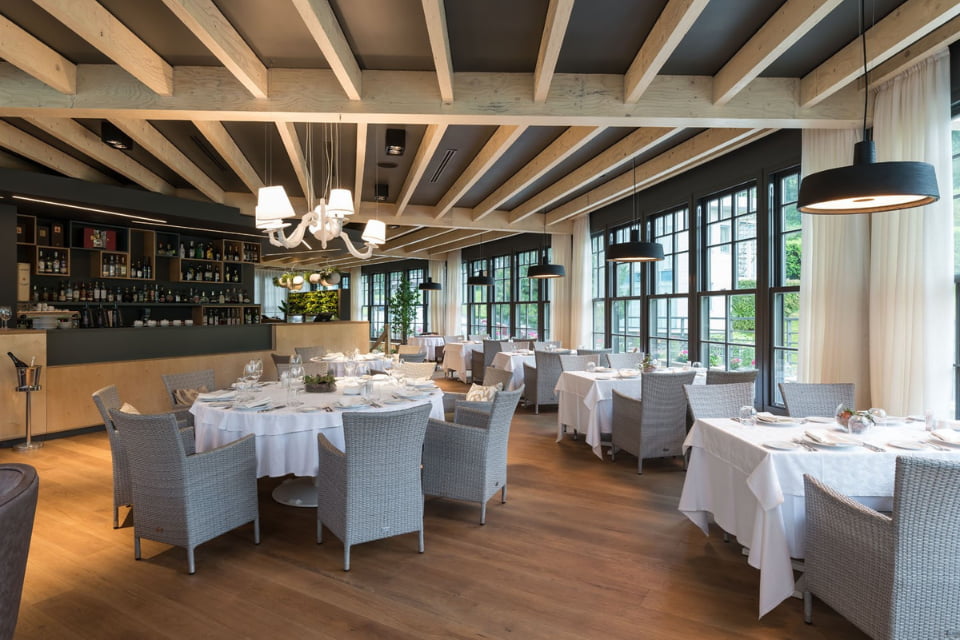
Déjà-Vu
The degrees of brightness best suited to the moments of the day
As we have repeatedly reiterated, in order to be able to choose the right type of decorative lighting for the restaurant in a targeted way, the kind of atmosphere you want to create must be defined first.
If the goal is to create intimacy, then it’s better to opt for some soft lights and one level of low lighting. By installing a dimmer it will be possible to modulate the light intensity if necessary.
If, on the contrary, you want to keep the clientele awake and attentive, then you should choose bright and inspiring lights.
This type of lighting is more suitable for locations such as ice cream parlors, cafes, or family restaurants, where the service is faster and smoother.
The number of potential lighting solutions also increases when we consider the times when the restaurant will remain open to the public.
The most attentive restaurants should consider the different lamp models available today for different times of the day.
If the project concerns the lighting of an outdoor restaurant or bar, especially during the day, the choice of decorative lighting will certainly be different from what you’d choose for a refined and romantic restaurant open only in the evening.
On the contrary, if the restaurant remains open all day, it would be more appropriate to choose suitable lighting solutions for each time slot of the day.
Find out how to best balance the lighting of your venue and let yourself be inspired by our projects!
Natural light: how to make the most of it
In any lighting design project, it is necessary to obtain the perfect integration between natural and artificial light.
Therefore, even before choosing decorative lighting for the restaurant, it is essential to assess its natural lighting potential.
Taking advantage of natural light is not only important to guarantee the right visual comfort, but also advantageous from the point of view of saving energy.
Certainly high windows and skylights, as well as large doors with glass panels, are elements that should be exploited to guarantee the penetration of the sun's rays and fill the rooms with light naturally.
However, it is essential to take the necessary precautions.
In fact, placing the dining room tables next to the window is a good solution, but you'll have to make sure they are not placed near doors, because you risk exposing guests to cold drafts or the confusion of foot traffic.
Also, it is important to keep in mind that customers seated facing east and west will practically have the sun in their eyes, so it is a good idea to install systems to counteract sunlight.
Furthermore, we must consider that the gradations of light will change with the seasons and will change the color of the interiors.
Evaluating all these factors will help you avoid making an error of judgment that would prove to be dysfunctional for the comfort of customers.
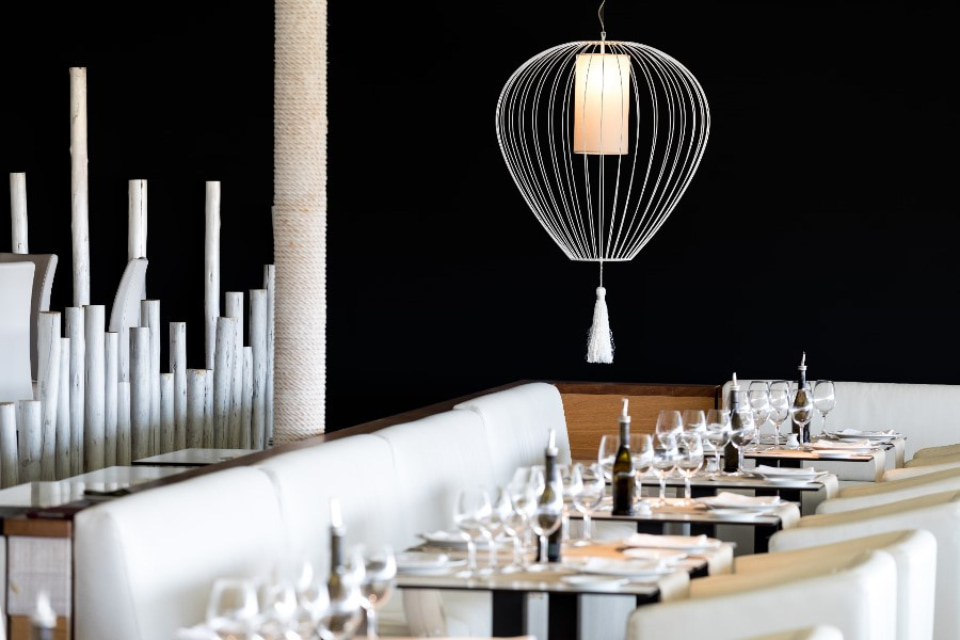
Cell
Decorative lighting styles based on the type of restaurant
Style is the soul of a restaurant and must be combined effectively with the type of restaurant that you want to offer.
Attention to the design and the aesthetics of the restaurant increasingly start from the correct choice of lamps.
So the first question to ask yourself is: what type of food service do you intend to offer?
A pub for groups of friends, a family restaurant, or an elegant bistro with a few tables?
There are different types of models, colors, and shades for each lamp that will be able to adapt specifically to the type of venue and the type of clientele to which it is addressed.
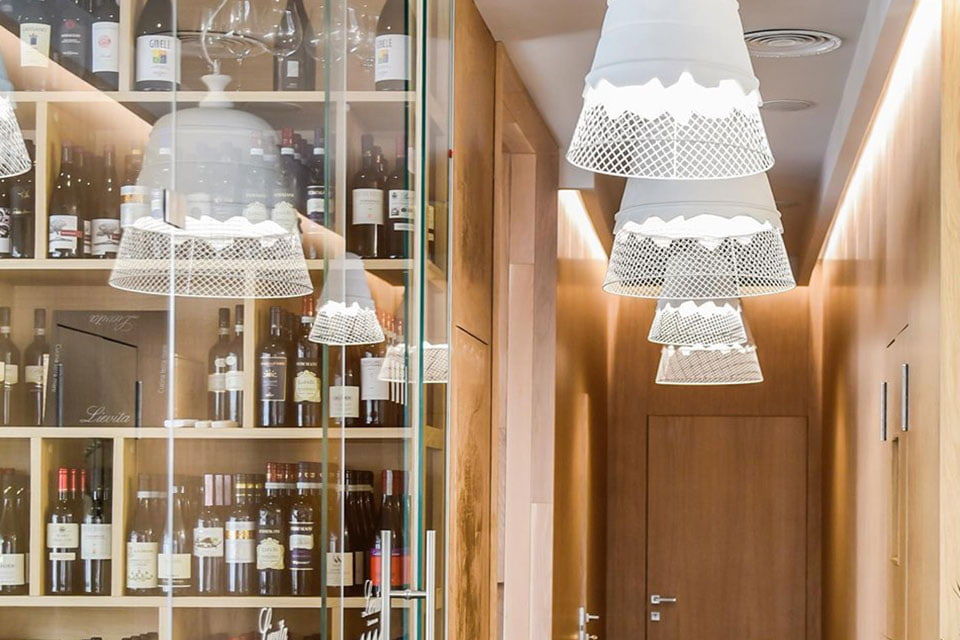
Domenica
Decorative lighting for restaurants: combining style and functionality
We have seen how decorative lighting plays a central role in the design and creation of a restaurant’s mood.
Indeed, it is capable of creating the right atmosphere with the psychology of light, and, for this reason, it deserves a whole series of assessments.
When it comes to choosing the right lighting solution, many factors need to be taken into consideration and the right steps followed to combine style and functionality.
By combining the different levels of lighting in a wider lighting design, it will be possible to create an effective but at the same time impactful atmosphere that is welcoming and will guide the guest in a unique sensory experience.
Filling the rooms with different atmospheres and using different shades of light will optimally illuminate spaces and pamper guests, making them feel immediately at ease.
Don’t forget that decorative lighting for the restaurant will have to be able to adapt to the type of venue and to express one's own idea of style.
Want to find out how our lamps have been positioned in some restaurant lighting projects? Download the catalog below!




